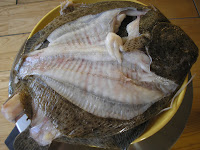But this blog is about a couple of the trimmings, specifically the gravy and the cranberry sauce. I stumbled upon Jamie Oliver's recipe for Get-Ahead Gravy and thought "that's a good idea"—less palaver before serving and knowing there is enough. I didn't have bacon and forgot about finishing with cranberry sauce, but even then, it was terrific. When making turkey gravy just before serving, it never gets to cook long enough and it doesn't get the extra vegetable flavour that this gravy gets. The recipe makes lots and there are leftovers that I'm going to freeze in small containers for those times I want a bit of gravy with the mashed potatoes.
 The cranberry sauce was another hit. I made it last year too but made no notes about it. I paid special attention this year and I now declare my search for the perfect cranberry sauce at an end. This is lovely stuff, not too sweet, with a fairly pronounced citrus component, which I really like. In fact, it's actually a cranberry cumberland sauce.
The cranberry sauce was another hit. I made it last year too but made no notes about it. I paid special attention this year and I now declare my search for the perfect cranberry sauce at an end. This is lovely stuff, not too sweet, with a fairly pronounced citrus component, which I really like. In fact, it's actually a cranberry cumberland sauce.Make-Ahead Poultry Gravy
This is slightly adapted from the original recipe. Based on comments and my own gut feeling, I reduced the amount of star anise. I also added a couple of garlic cloves. I think it was a good call. The resulting gravy has a hint of fennel/anise flavour but more would be overpowering. An alternative might be to include a quartered fennel bulb, but I didn't try this.
2 celery sticks, coarsely chopped
2 carrots,coarsely sliced
2 onions, peeled and quartered
2 cloves of garlic, smashed
5 bay leaves
5 sage leaves
4 sprigs of rosemary
1 star anise
2 rashers of bacon (I didn't have any, but I'm sure it would be great)
8 chicken wings
2-4 tablespoons olive oil salt and freshly ground black pepper
4 tablespoons flour
2 liters hot water
60ml sherry optional:
2 heaped tablespoons cranberry sauce, for finishing
- Preheat the oven to 200C (400F)
- Break the chicken wings open and pound them with a meat hammer or rolling pin to crack the bones open. (I put them in a plastic bag and used a rubber mallet.)
- Put the chopped vegetables, herbs, star anise, bacon (if using) and chicken wings in a roasting pan. Season with salt and pepper, drizzle with the olive oil, and stir it around to coat.
- Bake for an hour until the meat is tender and falling off the bone.
- Put the roasting pan on low heat on top of the stove.
- Use a potato masher to mash everything up, squeezing as much flavour and juice out of everything as you can.
- Gradually add the flour, and continue to mash, stir and brown for 5-10 minutes.
- Add 2 liters of hot water to deglaze the pan, scraping all the browned bits up.
- Transfer everything to a large pot, bring to a boil for 10 minutes until the sauce has thickened, and then simmer uncovered for 25 minutes, stirring occasionally. The liquid will reduce by about half.
- When it has reached the desired consistency, add the sherry, check and adjust the seasoning, then strain through a sieve into a large bowl. Mash as much stuff through the sieves as you can, then discard what remains.
- Let the gravy cool, pour into plastic containers or freezer bags, and freeze until the day you need it.
- You can heat it and use it as is, or if you have roasted a bird, remove as much fat as you can from the roasting pan, and use the pre-made gravy to deglaze the pan.
- Optionally, add some cranberry sauce and transfer to a pot to keep warm on low heat until use.
Cranberry Cumberland Sauce
- I adapted this recipe, mostly by adjusting the seasonings to suit the quantity of one 375 gram bag of cranberries.
- 200 ml ruby port
- 90 grams sugar
- 90 ml fresh orange juice
- 3/4 tsp corn flour
- 3/4 tsp English mustard powder
- 1 tsp lemon juice
- pinch of ground cloves
- 40 grams flaked almonds
- 2 tsp grated orange rind
- 1 tsp grated lemon rind
- Grate the peel of a large orange and juice the orange.
- Combine the cranberries, port, orange juice, and sugar in a pan and cook over medium heat for about 10 minutes until the berries burst.
- Mix the cornstarch, mustard powder, and ground cloves with a small amount of the cranberry liquid to create a paste. Stir into the cranberries.
- Add the dried cranberries or raisins, almonds, orange and lemon rind
- Simmer for five minutes, season, and then chill.

















































